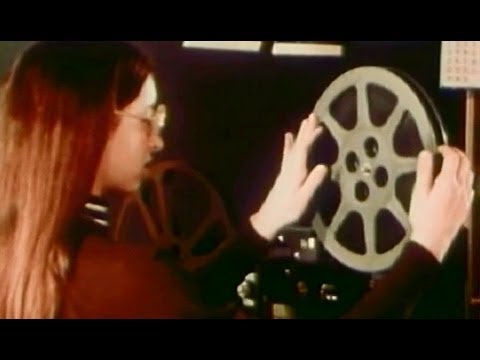more at
“Seventies-era students watch a film projected by a student projectionist. Shows that constant maintenance of equipment is necessary for satisfactory and successful film projection.”
Public domain film from the Prelinger Archive, slightly cropped to remove uneven edges, with the aspect ratio corrected, and mild video noise reduction applied.
The soundtrack was also processed with volume normalization, noise reduction, clipping reduction, and/or equalization (the resulting sound, though not perfect, is far less noisy than the original).
A movie projector is an opto-mechanical device for displaying motion picture film by projecting it onto a screen. Most of the optical and mechanical elements, except for the illumination and sound devices, are present in movie cameras…
Light source
Incandescent lighting and even limelight were the first light sources used in film projection. In the early 1900s up until the late 1960s, carbon arc lamps were the source of light in almost all theaters in the world.
The Xenon arc lamp was introduced in Germany in 1957 and in the US in 1963. After film platters became commonplace in the 1970s, Xenon lamps became the most common light source, as they could stay lit for extended periods of time, whereas a carbon rod used for a carbon arc could last for an hour at the most.
Most lamp houses in a professional theatrical setting produce sufficient heat to burn the film should the film remain stationary for more than a fraction of a second. Because of this, care must be taken in inspecting a film so that it should not break in the gate and be damaged, particularly if it is inflammable cellulose nitrate film stock.
Reflector and condenser lens
A curved reflector redirects light that would otherwise be wasted toward the condensing lens.
A positive curvature lens concentrates the reflected and direct light toward the film gate.
Douser
(Also spelled dowser.)
A metal or asbestos blade which cuts off light before it can get to the film. The douser is usually part of the lamphouse, and may be manually or automatically operated. Some projectors have a second, electrically controlled douser that is used for changeovers (sometimes called a “changeover douser” or “changeover shutter”). Some projectors have a third, mechanically controlled douser that automatically closes when the projector slows down (called a “fire shutter” or “fire douser”), to protect the film if the projector stops while the first douser is still open. Dousers protect the film when the lamp is on but the film is not moving, preventing the film from melting from prolonged exposure to the direct heat of the lamp. It also prevents the lens from scarring or cracking from excessive heat.
Film gate and single image
A single image of the series of images comprising the movie is positioned and held flat within an aperture called the gate. The gate also provides a slight amount of friction so that the film does not advance or retreat except when driven to advance the film to the next image.
Shutter
A commonly held misconception is that film projection is simply a series of individual frames dragged very quickly past the projector’s intense light source; this is not the case. If a roll of film were merely passed between the light source and the lens of the projector, all that would be visible on screen would be a continuous blurred series of images sliding from one edge to the other. It is the shutter that gives the illusion of one full frame being replaced exactly on top of another full frame. A rotating petal or gated cylindrical shutter interrupts the emitted light during the time the film is advanced to the next frame…
Film transport elements
Film supply and takeup
Two-reel system
In the two-reel system the projector has 2 reels–one is the feed reel, which holds the part of the film that has not been shown, the other is the takeup reel, which winds the film that has been shown. In a two-reel projector the feed reel has a slight drag to maintain tension on the film, while the takeup reel is constantly driven with a mechanism that has mechanical ‘slip,’ to allow the film to be wound under constant tension so the film is wound in a smooth manner.
The film being wound on the takeup reel is being wound “head in, tails out.” This means that the beginning (or “head”) of the reel is in the center, where it is inaccessible. As each reel is taken off of the projector, it must be re-wound onto another empty reel…

